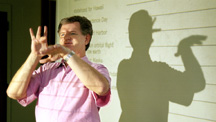 Purdue Lifestyles Briefs
Purdue Lifestyles Briefs
 Purdue Lifestyles Briefs
Purdue Lifestyles Briefs
NOTE TO JOURNALISTS: A color photo of a demonstration of American Sign Language is available. Ask for the photo called Brentari/ASL.
WEST LAFAYETTE, Ind. -- Purdue University has doubled the number of instructors teaching American Sign Language on its West Lafayette campus this year, but for every student enrolled in a class, two to three more are turned away.

|
At Purdue, the American Sign Language Program is based in the Department of Audiology and Speech Sciences. All eight sections being offered this fall are filled to capacity, meaning 160 students got the class they requested. Brentari estimates that as many as 400 more students did not.
A few years ago, the majority of students signed up for these classes were speech, education or nursing majors. But starting in the fall of 1993, the university approved sign language for foreign language credit, and demand for classes soared.
"Signing is a language that is indigenous to the United States," Brentari says. "Students realize that in this country they are likely to run into a deaf person during the course of their everyday lives."
Students learning American Sign Language have similar difficulties as those learning any foreign language. "Signing and reading someone else's signs are two very different skills, just as speaking a foreign language is different from being able to understand it," Brentari explains. And because signing is visual and gestural, she says, it offers a different perspective on language learning.
She says the classes have always been a popular option for future educators and health care professionals, but now business majors are starting to jump on the bandwagon.
"Not only do students see American Sign Language as a skill that will really stand out on their resume -- but businesses are also beginning to recognize the marketing opportunities with this particular population," Brentari says. "Deaf people are consumers, too."
CONTACT: Brentari, (765) 494-3789; e-mail, brentari @purdue.edu
Irradiation is little used and a lot misunderstood, but it can destroy the microorganisms responsible for food-borne illnesses and extend the shelf life of perishable foods. It is an FDA-regulated food preservation method using gamma radiation. It's currently used on foods such as spices, pork, poultry, and some fruits and vegetables. The FDA is considering approval for red meats.
Research shows irradiation poses no concern to consumers. "Decades of research on the safety of food irradiation show no changes to the food that are different from any other type of heat processing," says April Mason, Purdue University Cooperative Extension Service assistant director and a foods and nutrition specialist.
"It's really hard to process raw meat without getting some contamination on it, but if it's irradiated, the bacteria are killed," she says. "Irradiation is one more safety precaution. It's not in lieu of other safety precautions, such as proper cooking, but irradiation destroys the organism before it reaches the consumer."
Richard Linton, Purdue Extension specialist in food safety, says, "Cooking and irradiation are perhaps the only existing ways today to get rid of microorganisms on food."
An instance where irradiation would have been particularly helpful, Mason explains, was last spring when microbial organisms on strawberries and raspberries -- foods that often aren't cooked -- caused an outbreak of food-borne illness.
It also might have avoided the Hudson Foods recall of 25 million pounds of red meat, including hamburger patties, that may have been contaminated with E. coli , a microorganism that can cause illness and even death in those who consume it.
Linton says, "If I had a crystal ball that could predict the future, I'd say the Hudson hamburger incident may lead to consumer acceptance of irradiation in the next four or five years."
Mason agrees and adds: "Data show that consumers will accept food irradiation when they learn about it and taste irradiated food."
CONTACTS: Mason, (765) 494-8252; e-mail, masona@cfs.purdue.edu, or Linton, (765) 494-6481; e-mail, lintonr@foodsci.purdue.edu
Personal possessions can hold special memories for family members, and deciding how to distribute them may create problems. "Some people assume such decisions will take care of themselves," says Janet Bechman, Cooperative Extension Service specialist in consumer sciences and retailing. "But, in reality, the situation has resulted in many painful experiences that need not have occurred."
Grandma's private possessions may hold more sentimental value than financial value for her loved ones, Bechman says, so it's almost impossible to divide items fairly.
She suggests that individuals decide how their personal items be distributed before the time comes. "It is better to decide what will take place before a crisis occurs so that family members are not dealing with loss and pain at the same time," she says.
But whether a person is preparing to die or to move to a nursing home, or must give up possessions for another reason, Bechman says thinking about the change is painful. Talking about it is worse. "Discussing the distribution of personal belongings involves facing the issues of death and loss," she says.
If a loved one dies without distributing items, Bechman offers these methods of transfer that have been used by some families:
Writer: Beth Forbes, (765) 494-9723; e-mail, beth_forbes@purdue.edu
Purdue News Service: (765) 494-2096; e-mail, purduenews@purdue.edu
PHOTO CAPTION:
American Sign Language classes are filled to capacity at Purdue University. This popular
class provides a different perspective on learning a foreign language because it's
visual and gestural, as instructor Donald Haring demonstrates. (Purdue News Service
Photo by David Umberger)
Color photo, electronic transmission, and Web and ftp download available. Photo ID:
Brentari.ASL
Download here.